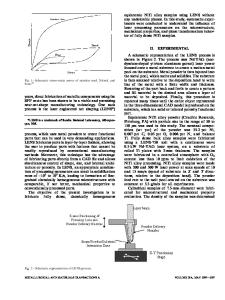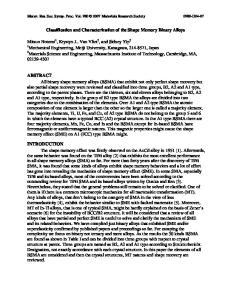Fabrication and Characterization of Cu-14Al-3.5Ni Shape Memory Alloy by Ingot Metallurgy
- PDF / 905,361 Bytes
- 6 Pages / 612 x 792 pts (letter) Page_size
- 107 Downloads / 363 Views
0888-V06-01.1
Fabrication and Characterization of Cu-14Al-3.5Ni Shape Memory Alloy by Ingot Metallurgy K. Jai Ganesh and Arunya Suresh Department of Metallurgical Engineering, Malaviya National Institute of Technology, Jaipur – 302017, Rajasthan, India. ABSTRACT Shape Memory Alloys (SMAs) are a class of SMART Materials exhibiting unique properties like superelasticity and shape memory effect (SME), which have made them suitable for potential applications. Although shape memory properties were first observed in 1951, in Au-47.5 at% Cd alloy, SMAs gained commercial importance in 1962 with the inception of Ni-Ti SMAs. Ni-Ti SMAs possessed versatile properties but posed fabrication problems. This led to the development of Cu-based SMAs, which eventually gained immense popularity due to their ease in fabrication, cost effectiveness and high temperature properties. This research aims at the fabrication of a Cu-14 Al-3.5 Ni (wt %) Shape Memory Alloy by a simple cost effective route followed by its characterization to correlate its structure and properties. The alloy of the desired composition was melted in an Electric Resistance Furnace at 1473 K and cast in a metallic mould. Homogenization of the alloy was carried out at 1123 K for twenty-four hours and its chemical composition was analyzed by Optical Emission Spectroscopy. The transformation temperatures of the alloy were determined using Differential Scanning Calorimetry. Heat treatment operations were subsequently carried out at 1273 K for one hour followed by quenching in different media. Optical and SEM micrographs were taken at various magnifications and the formation of self-accommodating martensite was observed. This was further confirmed by X-Ray Diffraction technique. Further improvements in the mechanical properties of the alloy by quaternary additions of Mn and Ti have been cited. Finally, SME was observed in a rolled strip of the alloy, thus concreting the obtained results. INTRODUCTION Shape Memory Alloys (SMAs) are SMART (Stimulated Martensite Austenite Reverse Transformation) materials possessing unique properties of Shape Memory Effect (SME) and Superelasticity (SE). SME was first observed in Au-47.5 at% Cd alloy, but research in this field became active with the discovery of Ni-Ti alloys, which possessed good shape memory properties, ductility and fatigue strength. However, higher material costs and complex fabrication processes led to the development of Copper-based SMAs [1] that provided good shape memory properties at elevated temperatures with minimum fabrication problems. Deploying a simple crucible melting technique to accurately achieve the desired composition has perspicuously vindicated the ease of fabrication of this alloy. Microstructure studies, after heat treatments in different media, revealed the presence of self-accommodating and reversible Martensitic phase responsible for the excellent shape memory properties of the alloy. Advanced characterization by SEM analysis and X-Ray diffraction technique provides details of the morphologies of
Data Loading...











